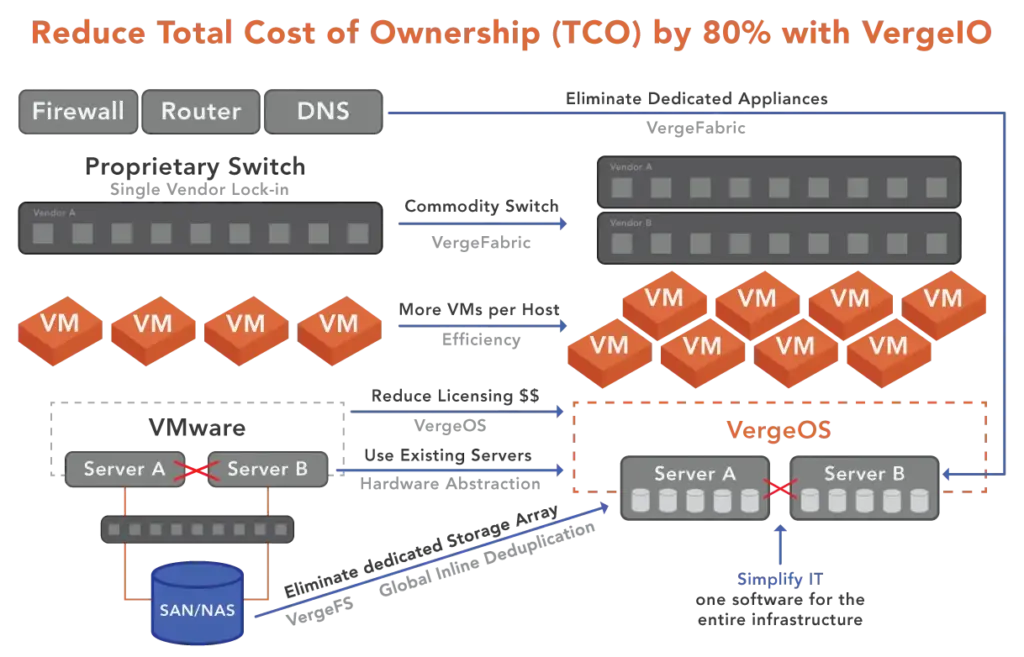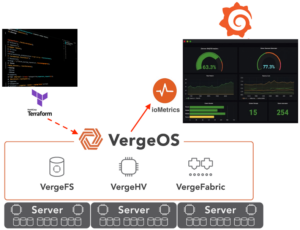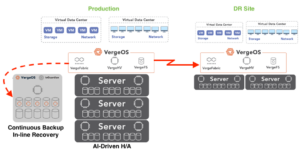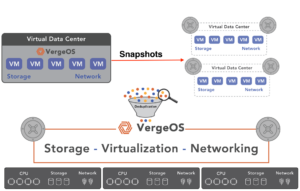Many IT professionals are considering alternatives to VMware to reduce licensing costs, but the sustainability benefits of efficient infrastructure software as it replaces VMware should not be overlooked. Infrastructure software that integrates storage services, server virtualization, and network services into a single code base can improve power and cooling costs, as well as resource utilization, to enable organizations to meet sustainability goals.

By requiring less CPU overhead, these solutions can significantly increase processor efficiency, which enables more virtual machines (VMs) per server, thereby reducing the number of physical servers required. It also extends the operational life of servers. These benefits contribute to environmental sustainability and cost efficiency. An efficient infrastructure software solution can also eliminate vendor lock-in, ensure long-term hardware flexibility, replace dedicated all-flash storage arrays with server-class SSDs, and incorporate backup best practices into the core infrastructure software. Additionally, solutions can reduce power, cooling, data center footprint, and server acquisition costs.
Enhancing Server Performance and Reducing Physical Server Count
Integrating storage, virtualization, and network services into a unified software package can improve server performance. Such software can handle more workloads with fewer physical servers by optimizing resource allocation and management. This reduction in physical infrastructure leads to several sustainability benefits:
- Lower Energy Consumption: Fewer servers mean reduced energy requirements for operation and cooling, directly lowering the data center’s carbon footprint.
- Reduced E-Waste: Minimizing the number of physical servers significantly decreases the amount of electronic waste generated from obsolete hardware.
- Cost Savings: Lower energy consumption and reduced hardware needs translate to substantial cost savings in capital and operational expenditures.
Elimination of Vendor Lock-In with Efficient Infrastructure Software
Vendor lock-in has long been a challenge in enterprise IT environments, and it impacts the sustainability benefits of efficient infrastructure software. Traditional infrastructure solutions bind organizations to specific hardware vendors, limiting flexibility and driving up costs. An efficient infrastructure software solution mitigates this issue by providing hardware-agnostic capabilities:
- Freedom of Choice: Organizations can choose hardware based on performance, cost, and sustainability criteria rather than being constrained by vendor compatibility.
- Competitive Pricing: The ability to mix and match hardware from different vendors fosters a competitive market, driving down prices and encouraging innovation.
- Sustainability Through Longevity: Hardware-agnostic software can support older servers, extending their useful life and reducing the need for frequent hardware replacements.
Efficient Infrastructure Software Delivers Long-Term Hardware Flexibility
One of the significant sustainability benefits of an efficient infrastructure software solution is its support for long-term hardware flexibility. This capability allows organizations to extend the operational life of their servers well beyond the original warranties:
- Extended Lifespan: With the correct software optimizations, servers can remain functional and efficient for many years, delaying the need for new hardware.
- Reduced Resource Consumption: By prolonging the life of existing hardware, the demand for raw materials and energy associated with manufacturing new servers is minimized.
- Economic Efficiency: Extending hardware lifespan translates to reduced capital expenditure on new equipment and better return on investment for existing assets.
However, as servers age, the risk of hardware failure increases. To mitigate this risk, built-in server redundancy and seamless failover capabilities are essential. Efficient infrastructure software should include these features to ensure continuous operation if an older server fails. This built-in redundancy allows workloads to be automatically transferred to functioning servers without disruption, maintaining high availability and reliability. Such resilience ensures that the extended use of older hardware does not compromise the overall stability and performance of the IT environment.
Eliminating Dedicated All-Flash Storage Arrays

Traditional data centers rely on dedicated all-flash storage arrays to meet high-performance processing and storage demands. However, this approach can be resource-intensive and costly. By integrating storage services directly into the server infrastructure and utilizing server-class SSDs, organizations can achieve comparable, if not superior, performance with greater efficiency:
- Cost Efficiency: Server-class SSDs are typically more cost-effective than dedicated all-flash storage arrays, reducing initial investment and ongoing maintenance costs.
- Improved Resource Utilization: Integrating storage into server infrastructure optimizes the use of existing resources, enhancing overall efficiency.
- Environmental Impact: The production of server-class SSDs generally requires fewer resources than all-flash storage arrays, contributing to a smaller environmental footprint.
- Elimination of Separate Network Infrastructure: Efficient infrastructure software eliminates the need for a separate network infrastructure dedicated solely to storage traffic, such as Fibre Channel or iSCSI. By consolidating storage traffic over existing Ethernet networks, organizations can reduce complexity, lower costs, and decrease the physical footprint of networking hardware. This simplification also reduces power and cooling requirements, further enhancing the sustainability of the IT environment.
Integrating Backup Best Practices Into Efficient Infrastructure Software
Incorporating backup and data protection best practices directly into the core infrastructure software eliminates the need for separate data protection architectures. This integration offers several sustainability and efficiency benefits:
- Simplified Management: A unified approach to data protection streamlines management processes, reducing the need for additional hardware and administrative overhead.
- Enhanced Resiliency: Integrated backup solutions ensure that data is consistently protected and readily recoverable, minimizing downtime and data loss.
- Resource Optimization: By leveraging existing infrastructure for backup purposes, organizations can avoid the additional energy and material costs associated with dedicated backup systems.
- Elimination of Separate Storage Systems and Servers: The integration of the data protection architecture eliminates the need for separate storage systems to store backup data and separate servers to run the backup software. This consolidation reduces the overall hardware footprint, significantly saving space, power, and cooling costs.
The Requirements of Efficient Infrastructure Software

Efficient infrastructure software must meet several essential requirements to support modern data centers effectively while promoting sustainability and cost-efficiency. These requirements include integrating essential components, multi-tenancy capabilities, data resiliency, high availability, and scalability.
- Integration of Major Components: The software must integrate the three major components of the data center—storage services, virtualization software, and networking services—into a single piece of software.
- Integrated Multi-Tenancy: The software should provide integrated multi-tenancy to eliminate the noisy neighbor problem and ensure fair resource distribution among different workloads.
- Data Resiliency and High Availability It should integrate data resiliency and high-availability features for servers to protect against hardware failures and ensure continuous operation.
- Scalability: The software must scale from as few as two servers to hundreds of servers, allowing it to meet a wide range of use cases from Remote Office/Branch Office (ROBO) setups all the way up to large Enterprise environments.
Conclusion
Verge.io’s VergeOS meets all the requirements for efficient infrastructure software and delivers on the sustainability benefits discussed. VergeOS integrates storage services, server virtualization, and networking services into a single, cohesive platform, ensuring seamless operation and high performance. Its built-in multi-tenancy eliminates the noisy neighbor problem, and its data resiliency and high-availability features protect against hardware failures.
In addition to these technical advantages, VergeOS offers significant cost savings. Its licensing model is per server instead of per core, enabling customers to purchase fewer, more CPU-dense servers. This approach reduces licensing costs and lowers the overall number of servers required, enhancing sustainability by reducing energy consumption and electronic waste. VergeOS is also software-based, which means you can use your existing hardware or purchase new servers from the vendor of your choice.

Organizations adopting VergeOS can achieve all the sustainability benefits while enjoying upfront savings compared to VMware. VergeOS’s ability to scale from two servers to 200 makes it versatile for various use cases, from small remote offices to large enterprise environments. By choosing VergeOS, organizations can meet their environmental goals and achieve long-term operational success.


